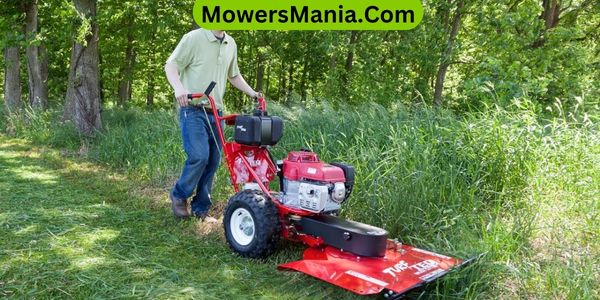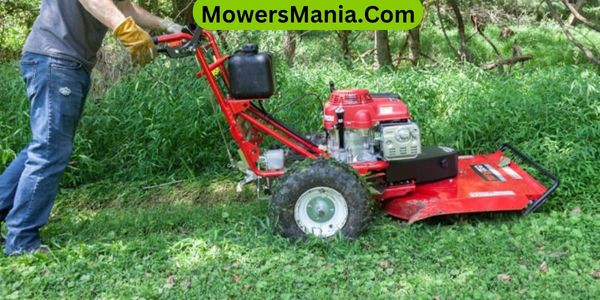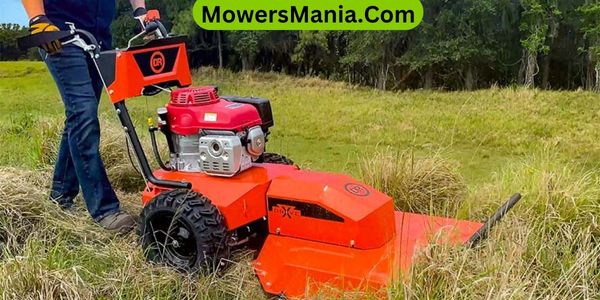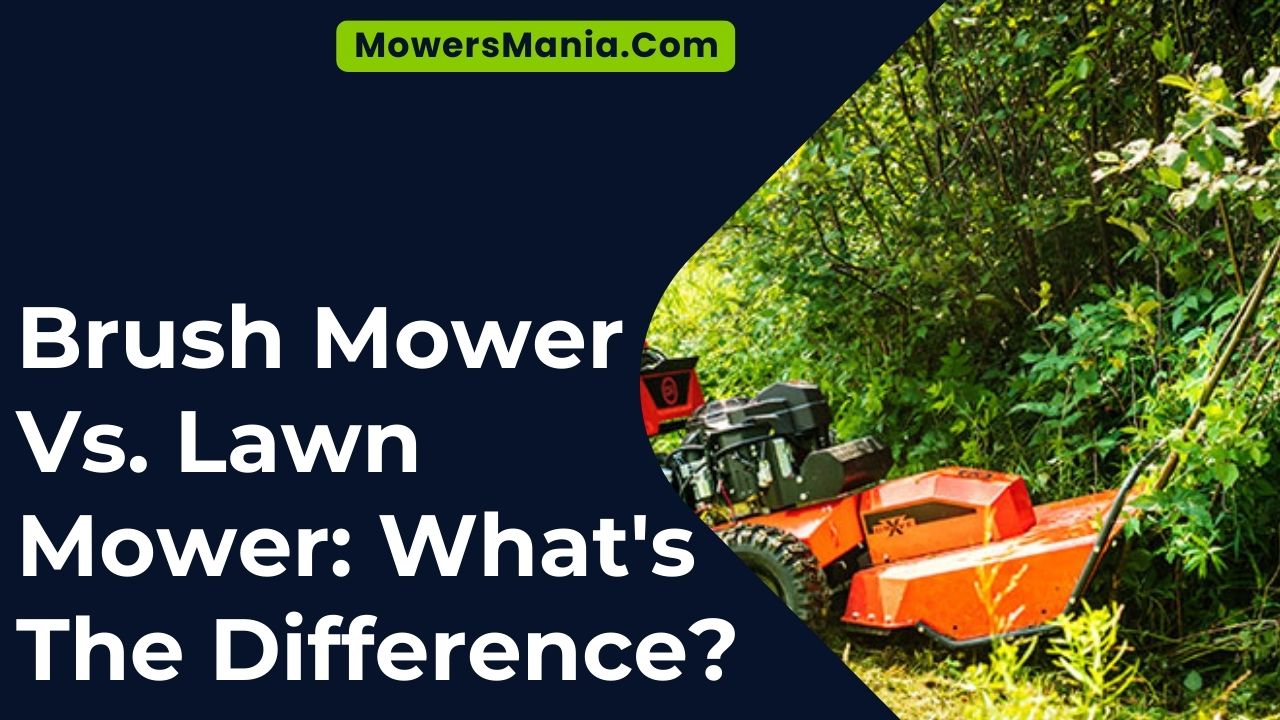Looking to tackle tough, overgrown vegetation? Wondering if a brush mower or a lawn mower is the right tool for the job?
This article breaks down the key differences between the two, from handling different types of terrain to the cutting mechanisms and maintenance requirements.

By the end, you’ll have a clear understanding of which one suits your landscaping needs best.
Types of Vegetation They Can Handle
With a brush mower, you can handle thick, overgrown vegetation that a regular lawn mower can’t handle. This means tackling tough, dense patches of brush, woody plants, and even small trees.
The brush mower’s powerful blades are designed to slice through these challenging types of vegetation with ease, making it the ideal tool for clearing out areas that have been neglected for some time.
In addition to handling thick vegetation, a brush mower is also capable of dealing with rough terrain, such as uneven ground, ditches, and slopes, which would be difficult for a regular lawn mower to navigate.
Furthermore, a brush mower can efficiently manage tall grass, weeds, and other unruly growth that may be present in fields, meadows, or along fence lines. Its robust construction and heavy-duty blades enable it to cut through these types of vegetation without getting clogged or bogged down.
This makes the brush mower a versatile and indispensable piece of equipment for maintaining large properties or tackling landscaping projects that require more muscle than a traditional lawn mower can provide.
Terrain and Landscaping Suitability

For tackling rough terrain and challenging landscaping projects, a brush mower provides the power and maneuverability needed to efficiently clear overgrown vegetation.
Unlike traditional lawn mowers, brush mowers are designed to handle rugged terrain, dense brush, and thick vegetation. This makes them well-suited for a variety of landscaping tasks, from clearing overgrown fields to maintaining trails and embankments.
The sturdy build and powerful engine of a brush mower allow it to navigate through uneven ground and tackle tough, woody plants that would bog down or damage a regular lawn mower.
Additionally, brush mowers often come with adjustable cutting heights, making them adaptable to various terrains and vegetation types.
The table below compares the suitability of brush mowers and lawn mowers for different terrains and landscaping projects:
| Terrain/Landscaping Project | Brush Mower Suitability | Lawn Mower Suitability |
|---|---|---|
| Rough, uneven terrain | Excellent | Limited |
| Overgrown brush | Excellent | Limited |
| Dense vegetation | Excellent | Limited |
| Trails and embankments | Excellent | Limited |
| Steep slopes | Good | Limited |
When it comes to handling challenging terrains and landscaping projects, a brush mower clearly outperforms a traditional lawn mower.
Cutting Mechanism and Blade Design
The cutting mechanism and blade design of a brush mower allow you to efficiently tackle thick vegetation and woody plants, making it a versatile tool for challenging landscaping projects.
Unlike traditional lawn mowers, brush mowers are equipped with heavy-duty blades specifically designed to handle dense, overgrown areas. These blades are often made of high-strength steel and feature a rugged, serrated edge that can easily slice through tough, woody vegetation.
Additionally, brush mowers typically have a wider cutting deck compared to standard lawn mowers, allowing for greater coverage and efficiency when dealing with rough terrain.
The blade design of a brush mower is optimized to minimize clogging and jamming, ensuring a smooth cutting experience even in the most demanding conditions. This cutting mechanism enables the brush mower to effectively clear brush, saplings, and other challenging vegetation with ease.
Whether you’re tackling thick undergrowth, clearing trails, or reclaiming overgrown areas, the cutting mechanism and blade design of a brush mower provide the power and precision needed to accomplish tough landscaping tasks.
Engine Power and Fuel Efficiency

To determine the difference in engine power and fuel efficiency between a brush mower and a lawn mower, you need to consider the specifications and capabilities of each machine.
Brush mowers generally have more powerful engines compared to traditional lawn mowers, as they’re designed to tackle tougher and thicker vegetation. This increased power allows brush mowers to handle heavy-duty cutting tasks more effectively.
On the other hand, lawn mowers are designed for maintaining well-kept lawns and thus have smaller engines optimized for lighter, more frequent use.
Additionally, the fuel efficiency of brush mowers may be lower due to the higher power output required for cutting dense brush and vegetation.
However, advancements in engine technology have led to improved fuel efficiency in newer models of brush mowers. This has made them more environmentally friendly and cost-effective to operate over time.
Understanding these differences in engine power and fuel efficiency can help you choose the right machine for your specific landscaping needs.
- Brush mowers have more powerful engines designed for cutting dense vegetation.
- Lawn mowers are optimized for lighter, more frequent use with smaller engines.
- Advancements in engine technology have improved the fuel efficiency of newer brush mower models.
Maintenance and Storage Requirements
When maintaining a brush mower or a lawn mower, you will need to store them properly and perform regular upkeep to ensure their optimal performance.
Both types of mowers require similar maintenance practices such as cleaning, oil changes, and blade sharpening, but there are also some differences in their specific requirements.
| Maintenance Task | Brush Mower | Lawn Mower |
|---|---|---|
| Cleaning | Remove debris and vegetation from | Clear grass clippings and debris |
| the cutting deck and blades | from the cutting deck and blades | |
| Oil Changes | Regular changes due to heavy-duty | Regular changes due to frequent |
| use and exposure to thicker | use and exposure to thinner | |
| vegetation | grass | |
| Blade Sharpening | Blades need less frequent | Blades require more frequent |
| sharpening due to cutting tougher | sharpening due to finer grass | |
| materials |
Proper storage is also crucial. Brush mowers should be stored in a dry place to prevent rust, while lawn mowers should be stored with an empty fuel tank to avoid damage from fuel deterioration.
By following these maintenance and storage guidelines, you can ensure that both your brush mower and lawn mower will continue to perform effectively.
Frequently Asked Questions [FAQs]
Can a Brush Mower Be Used to Clear Overgrown Areas With Thick Brush and Small Trees?
Yes, a brush mower can clear overgrown areas with thick brush and small trees. It’s designed for tough, dense vegetation. Make sure to use the appropriate safety gear and follow the manufacturer’s guidelines.
Is a Lawn Mower Suitable for Use on Rough, Uneven Terrain or Steep Slopes?
Yes, a lawn mower can handle rough, uneven terrain or steep slopes. It’s important to choose a model with high wheel clearance, good traction, and stability. Check for a self-propelled option for easier maneuvering.
Are There Any Specific Safety Precautions to Consider When Using a Brush Mower Compared to a Lawn Mower?
When using a brush mower compared to a lawn mower, always wear protective gear, like goggles and sturdy boots. Check the area for debris and rocks before mowing. Be mindful of the blade’s power and stay clear.
Can a Brush Mower Be Used to Clear Out Areas With Rocks, Roots, and Other Obstacles in the Way?
Yes, a brush mower can be used to clear out areas with rocks, roots, and other obstacles in the way. It’s designed to handle tough terrain and can cut through dense vegetation.
Are There Any Specific Maintenance Requirements for a Brush Mower Compared to a Lawn Mower?
When maintaining a brush mower, you’ll need to check and replace the blades more frequently than a lawn mower. It’s important to clear debris and inspect for any damage after each use to ensure optimal performance.
Conclusion
So, whether you’re tackling tough, overgrown brush or maintaining a well-manicured lawn, it’s important to choose the right mower for the job.
Consider the type of vegetation, terrain, cutting mechanism, engine power, and maintenance needs when deciding between a brush mower and a lawn mower.
Each has its own strengths and limitations, so choose wisely to ensure your outdoor space stays looking its best.



